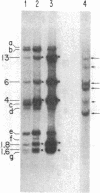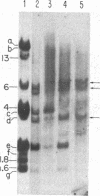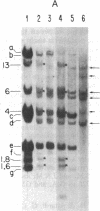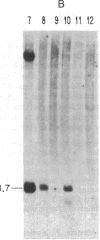Abstract
The chromosomal location of the human dihydrofolate reductase (DHFR; EC 1.5.1.3) gene that is amplified in a methotrexate-resistant human cell line has been investigated by screening a large number of human-mouse cell hybrids containing overlapping subsets of human chromosomes. A correlation of genomic blotting data with the chromosome constitution of the individual cell hybrids has allowed the assignment of the human DHFR gene to chromosome 5. This chromosome assignment has been confirmed by the observation of a concomitant loss of the human DHFR gene and of sensitivity to diphtheria toxin, a marker associated with chromosome 5, in two human-mouse cell hybrids selected for resistance to the toxin. Six EcoRI fragments of human DNA containing DHFR pseudogenes or other DHFR-related sequences have been assigned to chromosomes other than chromosome 5.
Full text
PDF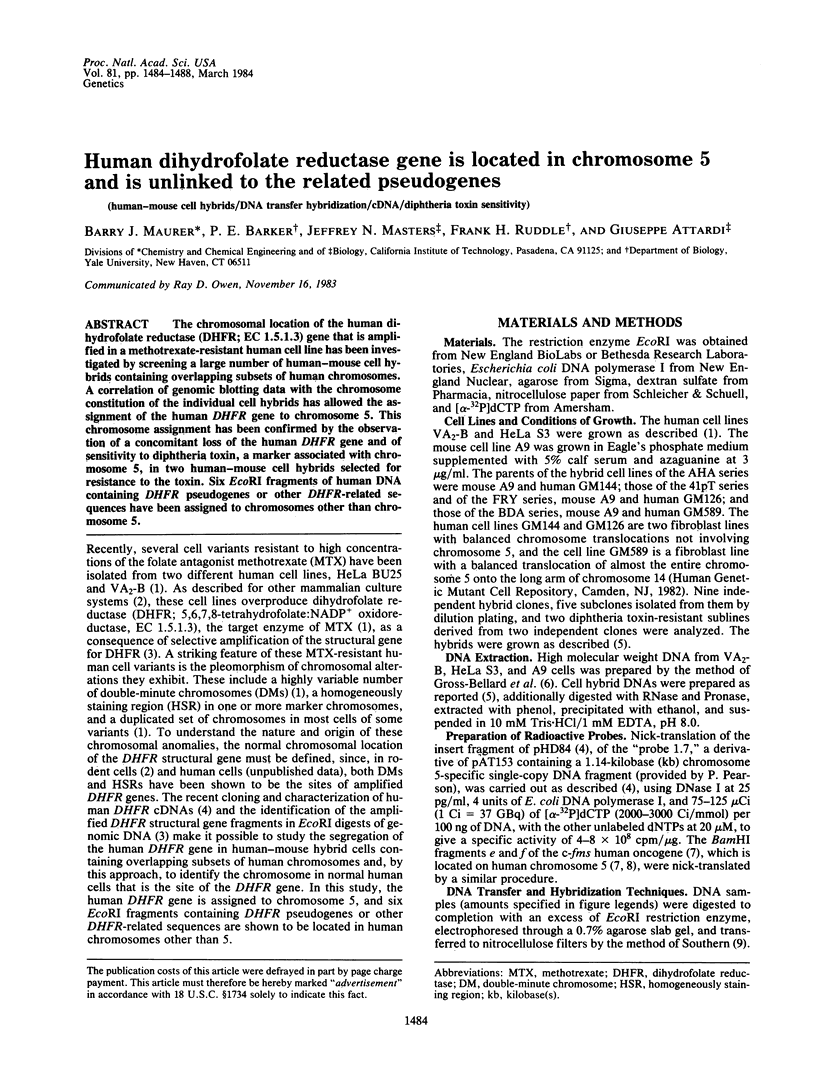
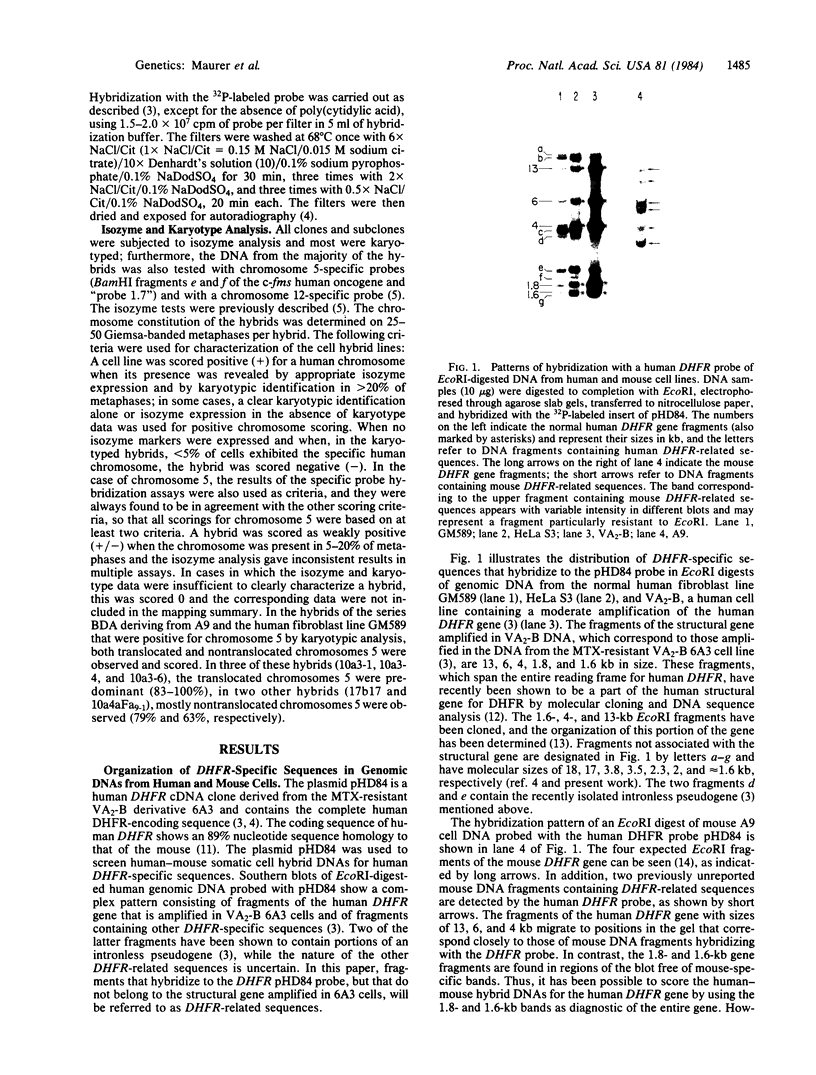
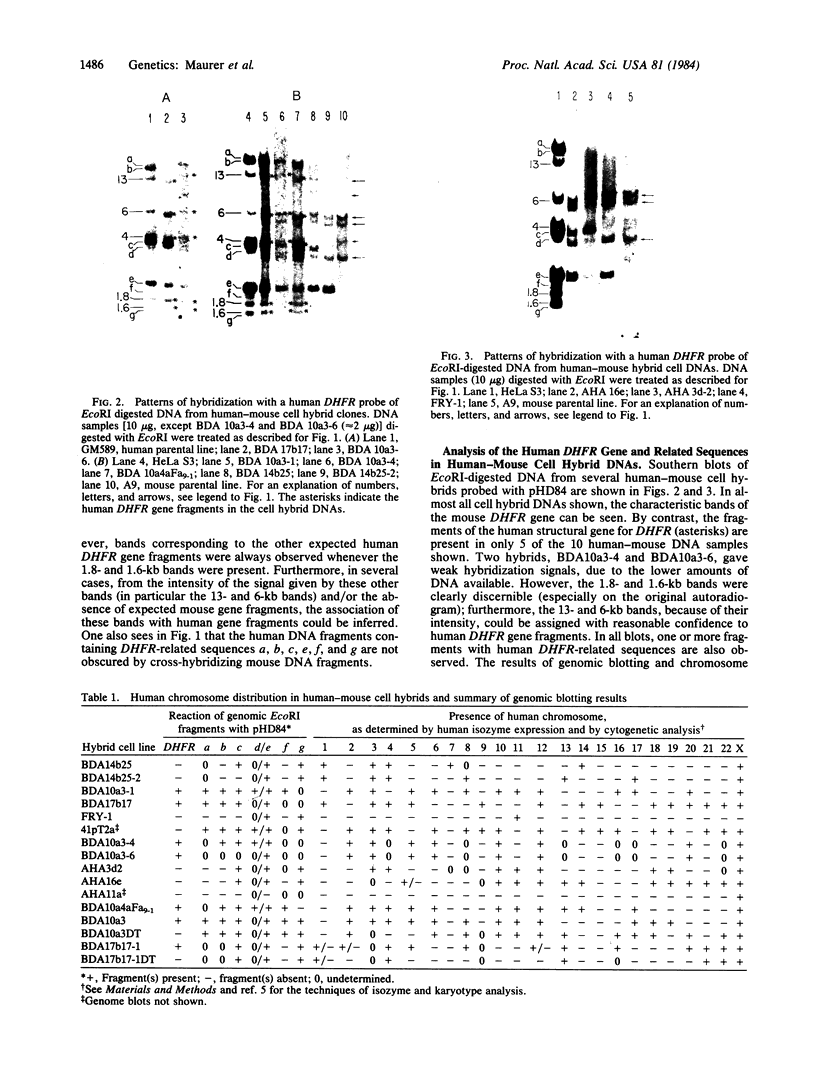

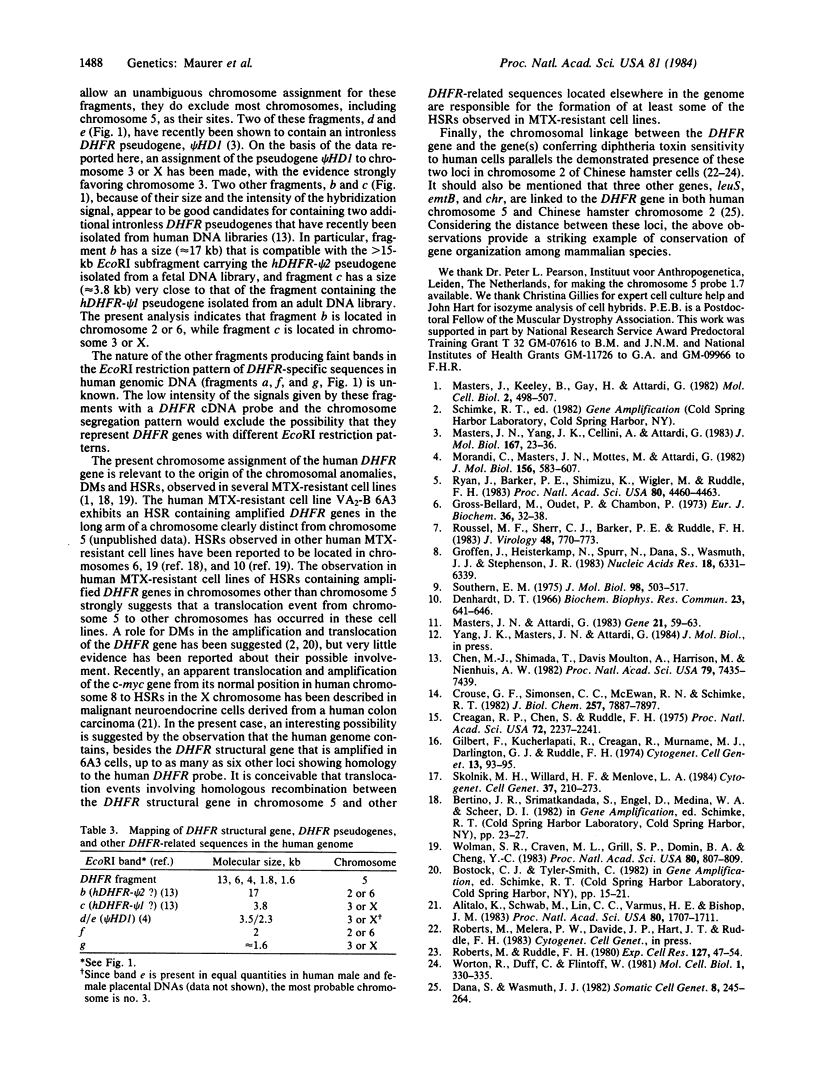
Images in this article
Selected References
These references are in PubMed. This may not be the complete list of references from this article.
- Alitalo K., Schwab M., Lin C. C., Varmus H. E., Bishop J. M. Homogeneously staining chromosomal regions contain amplified copies of an abundantly expressed cellular oncogene (c-myc) in malignant neuroendocrine cells from a human colon carcinoma. Proc Natl Acad Sci U S A. 1983 Mar;80(6):1707–1711. doi: 10.1073/pnas.80.6.1707. [DOI] [PMC free article] [PubMed] [Google Scholar]
- Chen M. J., Shimada T., Moulton A. D., Harrison M., Nienhuis A. W. Intronless human dihydrofolate reductase genes are derived from processed RNA molecules. Proc Natl Acad Sci U S A. 1982 Dec;79(23):7435–7439. doi: 10.1073/pnas.79.23.7435. [DOI] [PMC free article] [PubMed] [Google Scholar]
- Creagan R. P., Chen S., Ruddle F. H. Genetic analysis of the cell surface: association of human chromosome 5 with sensitivity to diphtheria toxin in mouse-human somatic cell hybrids. Proc Natl Acad Sci U S A. 1975 Jun;72(6):2237–2241. doi: 10.1073/pnas.72.6.2237. [DOI] [PMC free article] [PubMed] [Google Scholar]
- Crouse G. F., Simonsen C. C., McEwan R. N., Schimke R. T. Structure of amplified normal and variant dihydrofolate reductase genes in mouse sarcoma S180 cells. J Biol Chem. 1982 Jul 10;257(13):7887–7897. [PubMed] [Google Scholar]
- Dana S., Wasmuth J. J. Linkage of the leuS, emtB, and chr genes on chromosome 5 in humans and expression of human genes encoding protein synthetic components in human--Chinese hamster hybrids. Somatic Cell Genet. 1982 Mar;8(2):245–264. doi: 10.1007/BF01538680. [DOI] [PubMed] [Google Scholar]
- Denhardt D. T. A membrane-filter technique for the detection of complementary DNA. Biochem Biophys Res Commun. 1966 Jun 13;23(5):641–646. doi: 10.1016/0006-291x(66)90447-5. [DOI] [PubMed] [Google Scholar]
- Gilbert F., Kucherlapati R., Creagan R., Murnane M. J., Darlington G. J., Ruddle F. H. Proceedings: Hexosaminidase B: assignment of a locus involved in its expression to chromosome 5 in man. Cytogenet Cell Genet. 1974;13(1):93–95. doi: 10.1159/000130244. [DOI] [PubMed] [Google Scholar]
- Groffen J., Heisterkamp N., Spurr N., Dana S., Wasmuth J. J., Stephenson J. R. Chromosomal localization of the human c-fms oncogene. Nucleic Acids Res. 1983 Sep 24;11(18):6331–6339. doi: 10.1093/nar/11.18.6331. [DOI] [PMC free article] [PubMed] [Google Scholar]
- Gross-Bellard M., Oudet P., Chambon P. Isolation of high-molecular-weight DNA from mammalian cells. Eur J Biochem. 1973 Jul 2;36(1):32–38. doi: 10.1111/j.1432-1033.1973.tb02881.x. [DOI] [PubMed] [Google Scholar]
- Masters J. N., Attardi G. The nucleotide sequence of the cDNA coding for the human dihydrofolic acid reductase. Gene. 1983 Jan-Feb;21(1-2):59–63. doi: 10.1016/0378-1119(83)90147-6. [DOI] [PubMed] [Google Scholar]
- Masters J. N., Yang J. K., Cellini A., Attardi G. A human dihydrofolate reductase pseudogene and its relationship to the multiple forms of specific messenger RNA. J Mol Biol. 1983 Jun 15;167(1):23–36. doi: 10.1016/s0022-2836(83)80032-1. [DOI] [PubMed] [Google Scholar]
- Masters J., Keeley B., Gay H., Attardi G. Variable content of double minute chromosomes is not correlated with degree of phenotype instability in methotrexate-resistant human cell lines. Mol Cell Biol. 1982 May;2(5):498–507. doi: 10.1128/mcb.2.5.498. [DOI] [PMC free article] [PubMed] [Google Scholar]
- Morandi C., Masters J. N., Mottes M., Attardi G. Multiple forms of human dihydrofolate reductase messenger RNA. Cloning and expression in Escherichia coli of their DNA coding sequence. J Mol Biol. 1982 Apr 15;156(3):583–607. doi: 10.1016/0022-2836(82)90268-6. [DOI] [PubMed] [Google Scholar]
- Roberts M., Ruddle F. H. The Chinese hamster gene map. Assignment of four genes (DTS, PGM2, 6PGD, EnoI) to chromosome 2. Exp Cell Res. 1980 May;127(1):47–54. doi: 10.1016/0014-4827(80)90413-9. [DOI] [PubMed] [Google Scholar]
- Roussel M. F., Sherr C. J., Barker P. E., Ruddle F. H. Molecular cloning of the c-fms locus and its assignment to human chromosome 5. J Virol. 1983 Dec;48(3):770–773. doi: 10.1128/jvi.48.3.770-773.1983. [DOI] [PMC free article] [PubMed] [Google Scholar]
- Ryan J., Barker P. E., Shimizu K., Wigler M., Ruddle F. H. Chromosomal assignment of a family of human oncogenes. Proc Natl Acad Sci U S A. 1983 Jul;80(14):4460–4463. doi: 10.1073/pnas.80.14.4460. [DOI] [PMC free article] [PubMed] [Google Scholar]
- Skolnick M. H., Willard H. F., Menlove L. A. Report of the Committee on Human Gene Mapping by Recombinant DNA Techniques. Cytogenet Cell Genet. 1984;37(1-4):210–273. doi: 10.1159/000132011. [DOI] [PubMed] [Google Scholar]
- Southern E. M. Detection of specific sequences among DNA fragments separated by gel electrophoresis. J Mol Biol. 1975 Nov 5;98(3):503–517. doi: 10.1016/s0022-2836(75)80083-0. [DOI] [PubMed] [Google Scholar]
- Wolman S. R., Craven M. L., Grill S. P., Domin B. A., Cheng Y. C. Quantitative correlation of homogeneously stained regions on chromosome 10 with dihydrofolate reductase enzyme in human cells. Proc Natl Acad Sci U S A. 1983 Feb;80(3):807–809. doi: 10.1073/pnas.80.3.807. [DOI] [PMC free article] [PubMed] [Google Scholar]
- Worton R., Duff C., Flintoff W. Microcell-mediated cotransfer of genes specifying methotrexate resistance, emetine sensitivity, and chromate sensitivity with Chinese hamster chromosome 2. Mol Cell Biol. 1981 Apr;1(4):330–335. doi: 10.1128/mcb.1.4.330. [DOI] [PMC free article] [PubMed] [Google Scholar]



